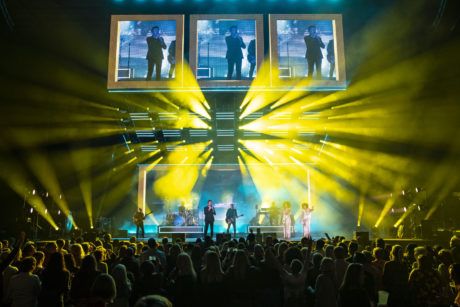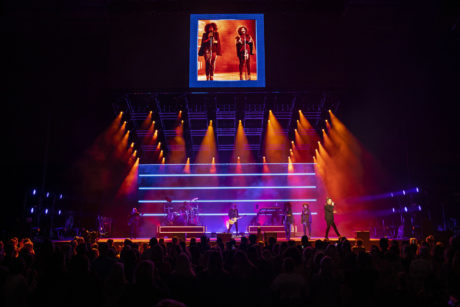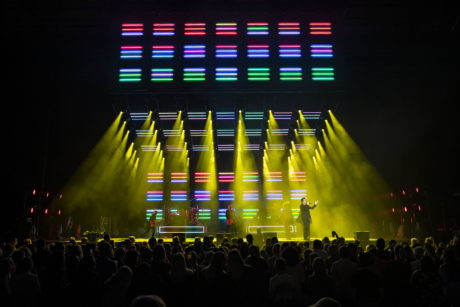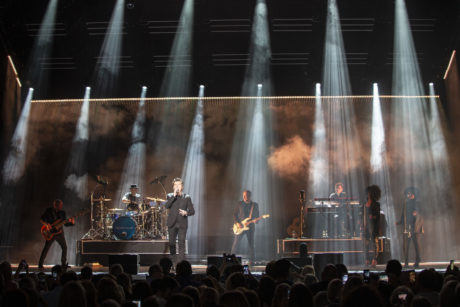
UK – Rick Astley – global 1980’s dance pop guru – who retired from the music industry in 1993 aged 27 with a string of foot-tappingly infectious and successful tunes to his name – is back on the road with a brand-new album. Beautiful Life influenced by his passion for rich, interactive soul and the same rhythmic integrity that made the likes of “Never Gonna Give You Up” and others such universal hits!
More details from HSL (www.hslgroup.com):
With many people unsure of what to expect, Astley delivered a stunningly diverse show, action-packed with the dynamics of soul, rock, R ‘n’ B, dance and more than a few hints of disco – even a stonking rendition of AC/DC classic ‘Highway To Hell’ back on his native drums – proving himself a top entertainer and keeping audiences enrapt with humor and a lively musical mix, backed by a talented, super-tight band and a stunning stage design by Andy Hurst.

HSL was delighted to be delivering the moving, grooving Rickrolling lighting equipment for this high-profile tour that captured the imagination of the British public. The Blackburn based company was once again working with renowned production manager Tony Gittins, with Jordan Hanson project managing.
He commented, “It was fantastic to be on the road with Tony and his excellent team again, and we were all very impressed with the look and style that Andy’s design bought to the show”.
Andy explained that there was no brief or initial meeting for the show design, so he listened to the new album and produced the classy, almost sculptural design which Rick and his management selected. The look included two identical lightweight 10mm Leyard video screens – each measuring 12 meters wide by 4 meters high – one upstage, and one that flew in and out on Kinesys points which was downstage. These were connected by a grid of gently raked upstage / downstage orientated trusses which provided over-stage lighting points.

This architecture brought a sense of depth, perspective and geometric order to the performance space. Its definition made a big statement and neatly and interestingly accommodated all the live show elements.
“I wanted a ‘connected’ look and the sense of one structure that could be unfolded” explained Andy, who wanted to have something elegant and dynamic with a touch of glamour AND a definite edge.
It was important to make the video screens look like set pieces, so the idea of 3D digital frames for all the video action came into play, devised by himself and video director Ben Miles, who ran the playback content and cut the camera mix.
To emphasize the architectural parameters of the design, Andy spec’d Martin Sceptron LED battens to fill the spaces in the ‘roof’ section between the eight 6-metre lighting trusses making up the grid. This itself was outlined with GLP X4 Bar 10s and 20s which are also mappable LED strip products.
Out on the road as Andy’s lighting director was Mark Jones-Roberts who he met whilst studying at Croydon School of Art & Design, and Mark is also a well-known LD in his own right. They have collaborated on a few projects in recent years and Andy was very pleased when Mark was able to take on this one.
The main lighting fixtures on the grid were 48 x Martin Mac Viper profiles – a favorite of Andy’s – six per truss.

In between each truss were nine Sceptrons in three banks of three which made up the grid lines and provided a bright, individually pixel mapped source which could be used for complex and fluid chases and flow effects. Andy remarks that the Sceptrons also took ambient up-light coming from the floor really well, creating a set effect when not in use.
The total Sceptron count was 105 as they were also used to line the two upstage risers, so they appeared to be floating which was highly effective. The subtle differences in the Sceptrons also worked nicely combined with the X4 Bars around the perimeters of the grid and screens.
There was no front lighting apart from two follow spots on Astley. Instead, Andy used side booms to get some very efficient cross lighting and rich colouration onto the band – positioned upstage on risers and the floor – from six MAC Auras a side on three booms a side, plus some Viper Performances at floor level.
There were 13 x MAC Viper performances in total, four each side and five along the back wall, and these were chosen for their power and accurate shuttering. Also upstage at the base of the screen, was a line of 15 x Claypaky SharBars for multibeam effects.
Nitro strobes were dotted around, with a line upstage on the deck and another dozen on the front truss where they lit the rig so it popped out ‘cartoon style’ into everyone’s consciousness, allowing the structural symmetry to be appreciated as part of the look.
The Nitros on the front LX truss were also used as Mole-style washes as well as traditional strobing.
It was important to get the right blend of atmospherics, so three Smoke Factory Tour Hazers were deployed upstage and offstage which ran for the entire show, augmented with a pair of Chauvet Cumulus low fog machines that use distilled water affected by an ultrasonic agitator to produce an authentic low lying mist for “Rise Up”, one of the encore numbers.
The video kit was all supplied by Universal Pixels and included disguise media server for the playback content and five cameras – two Hitachi SK-1200s stationed at FOH (with J40 lens) and in the pit (with HJ23 lens), and three Agile 360 Lite remote cams which were dotted around onstage.
The front screen was moved in and out – just twice – but with max impact!
It started in the ‘in’ position at the top of the show, which Astley opened standing dramatically silhouetted alone at the front of the stage, launching into “Try”. The screen then came in at the end of the set as Astley and the band exited. It was moved utilizing four of HSL’s Kinesys motors.
Mark ran the lighting, including the pixel-mapped Sceptrons, the X4 Bars and the smoke and haze devices on a Whole Hog Full Boar console.
One of the overall design challenges was to keep it scalable and adaptable as A and B systems to accommodate the mix of venues – from arenas to concert halls. It reduced to the B look extremely efficiently and stepped up impressively for a massive presence in the largest spaces like Manchester Arena, the mark of an intelligent and practical design.
Due to Andy’s hectic work schedule he was only in the country for a limited amount of the rehearsal period, however he and Mark took full advantage of HSL’s extensive WYSIWYG facilities to visualize the show get the major building blocks programmed and established, so by the time Mark went into production rehearsals at LS-Live in Wakefield, he was well ahead of the game.
Mark commented that the service from HSL had been “exemplary … as you would expect from a well organized leading rental company” and he really enjoyed working with his “fabulous” HSL crew of Ian Stevens, Andy Whittaker, Jake “Jevo” Jevons and Keith Parrot.
Photos: Louise Stickland.


